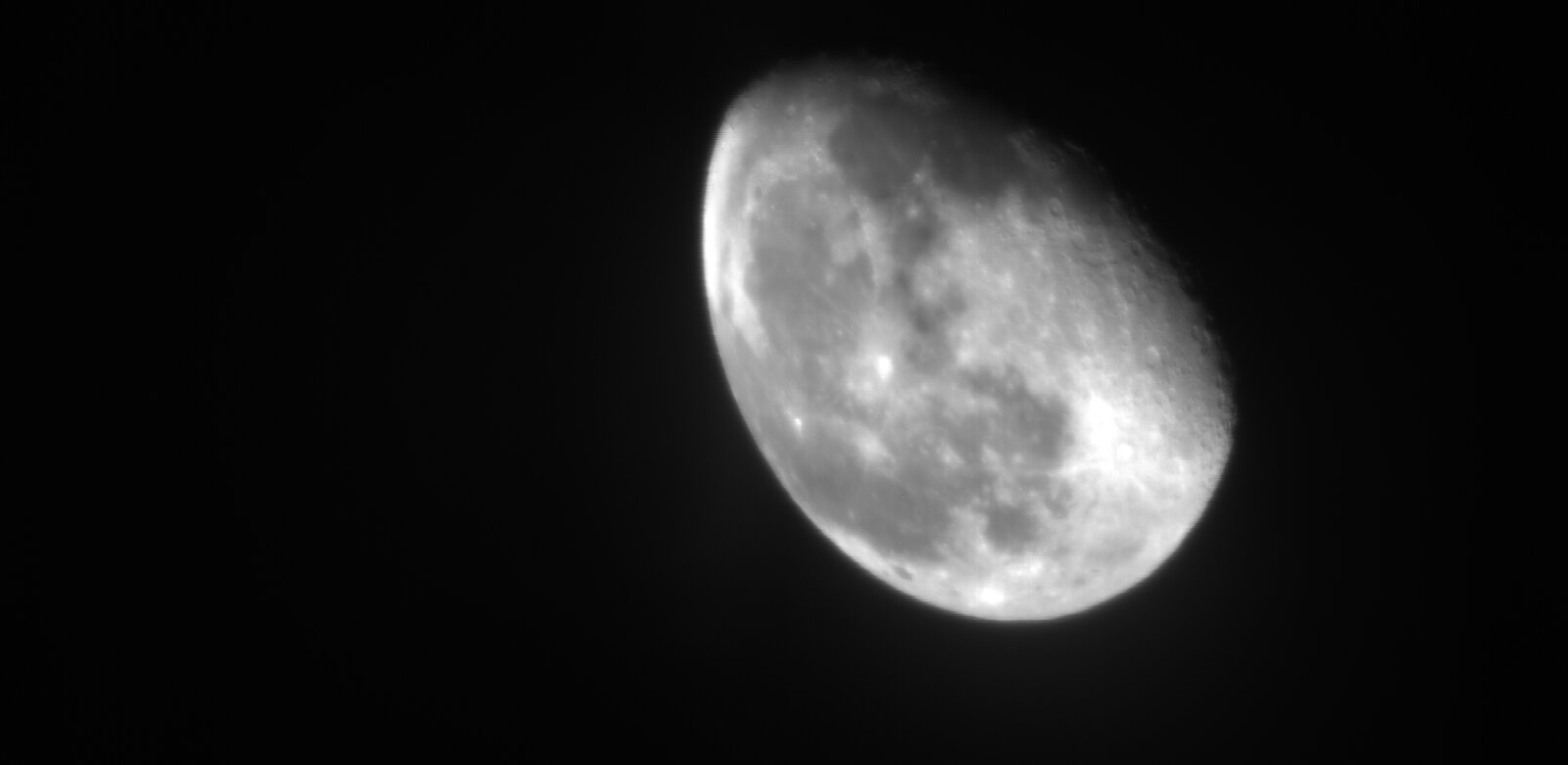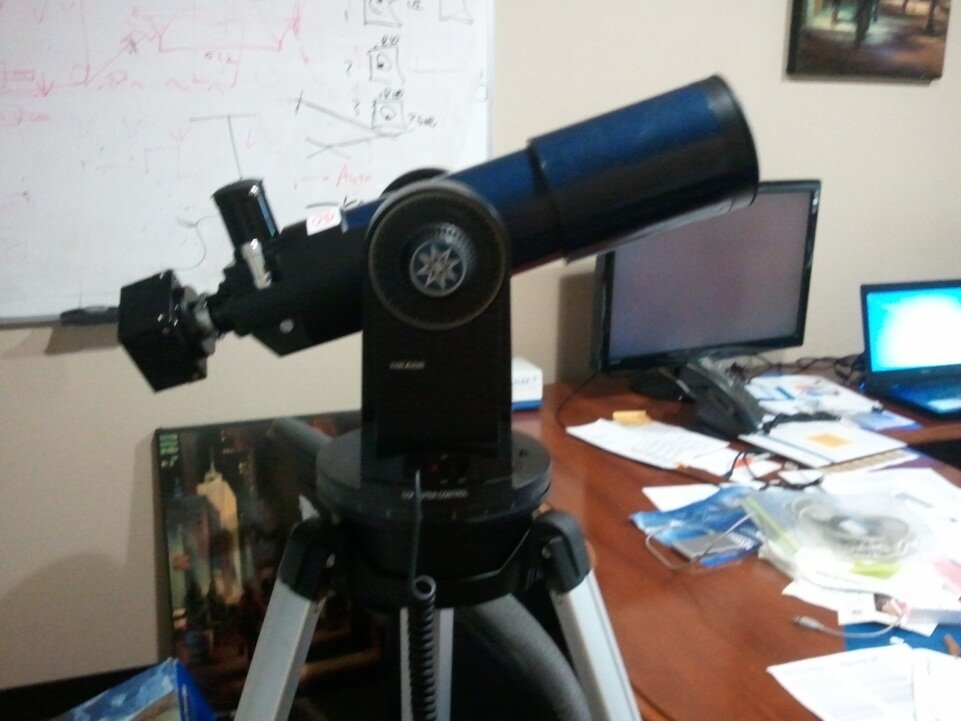Line-scanning is a digital photography technique that uses a special camera with only a single line of pixels instead of the usual rectangular area. Rather than taking an image all at once, the camera and object are typically moved relative to each other while many lines are acquired. These lines are assembled to make an image. This technique has some unique abilities such as the ability to image all the way around round objects without any gap or to image very large areas more uniformly and with higher resolution than would be otherwise possible.
At the recent National Instruments users’ group meeting hosted at DMC, a participant asked me if any object was too big to line-scan. “No,” I responded. “Anything can be line-scanned. We could even line-scan the moon if we wanted.” With this reply, I gave myself a challenge.
Relative motion is required in line-scanning. Typically, the camera is held stationary while the object of interest is moved past it, although the camera could be in motion with the object stationary. A common non-industrial application of line-scanning is the finish line at a horse-race or track event. In that application, the line-scan camera is mounted vertically at the finish line and acquires lines on a timed basis as the racers streak past. Each vertical line of the image represents a moment of time, and they are assembled from right to left in order of oldest to newest. Whichever racer appears in the furthest right vertical line arrived at the finish first.
In industrial applications, the camera can be mounted stationary looking at a moving object on a conveyor or a sheet of material as it passes by on rollers.
The line-scanning can also be used to image the entire circumference of a round part by mounting the camera outside the object and rotating the whole part through the line of view.
For the Moon Scan image, we used a combination of these techniques. The moon and the earth are in relative motion to each other. There are 2 components of this motion:
1. The moon orbits the earth with a period of ~28 days.
2. The earth spins within the moon’s orbit with a period of 1 day.
The second component is the dominant driver of relative motion between the earth and the moon. It is what causes the moon to apparently travel from the eastern horizon to the western every day. The orbital motion is actually opposed to the relative motion from the earth spinning. The moon is actually traveling from west to east, causing the moon rise to be later each day than the previous; however, this velocity is overcome by the rate of the earth’s rotation, so we see the moon travel only from east to west.
In order to line-scan the moon, we aimed the camera ahead of the moon and scanned on a timed basis as the moon passed by. We connected the camera to a Mead 80mm refracting telescope with a 400mm focal length. The line-scan camera’s sensor is very large, 10 microns per pixel or 20.48mm wide in total. A quick calculation showed we would only use a fifth of the field of view, so we placed a 2X focal length extender between the camera and the scope to increase the utilized field of view to almost half.
The focal length extender had the negative impact of decreasing the effective aperture of the lens from f/5 to f/10. This leads to the next interesting question: is the moon bright enough to line-scan? The equations for motion blur in line-scan imaging are the same as for standard 2D imaging. If the object moves more than 1 pixel within the exposure time then you get motion blur. The difference between line-scan imaging and standard 2D imaging is that with line-scan imaging, you can’t set the exposure time longer than the distance between pixels, because it will be time to take the next pixel and the camera will be still taking the last one.
Fortunately, the moon is very well lit. Except during an eclipse, half of the moon is in direct sunlight. On the night we did our imaging, 85% of the moon’s illuminated portion was facing the Earth. Despite being very far away, the moon’s sandy surface is just as bright to a camera as the sand on a beach on a sunny day. We were able to achieve a reasonable exposure of the moon with an 8ms exposure time. This fits well within the 150ms per line rate that we needed to get the aspect ratio of the moon approximately right.
We set the camera to take 400 lines per minute for 1000 lines and pointed the telescope just above the moon. The camera acquired lines for 2.5 minutes to achieve the image shown. The image is limited in its sharpness by the haze over downtown Chicago when it was taken. We were cut off from fine-tuning the focus and exposure time by the clouds that rolled in after the second image.

The first scan had too much time between lines, resulting in a short and fat aspect ratio. The interesting thing about the line-scan method is that the horizontal and vertical resolutions are independent. The horizontal resolution is dictated by the sensor size, the optics, and the working distance. The vertical resolution is based on the distance traveled by the object between each scan, which can be controlled independently.

On the second scan, we decreased the time between lines which made the moon closer to the round shape we expect to see. Also, we dropped the exposure time a bit to reduce the amount of the moon which is over-exposed.
We used a Basler ruL2048-19gm line-scan camera with a Gigabit Ethernet interface. Since the line period was outside the camera’s internal capabilities, we triggered it with a digital IO interface from a National Instruments EVS-1464RT.

Notice that the camera is mounted diagonally on the scope. We did this because the moon was rising diagonally from the east to its maximum height of about 50 degrees in the south. The camera is tilted to align the sensor approximately perpendicular to the moon’s direction of relative motion.